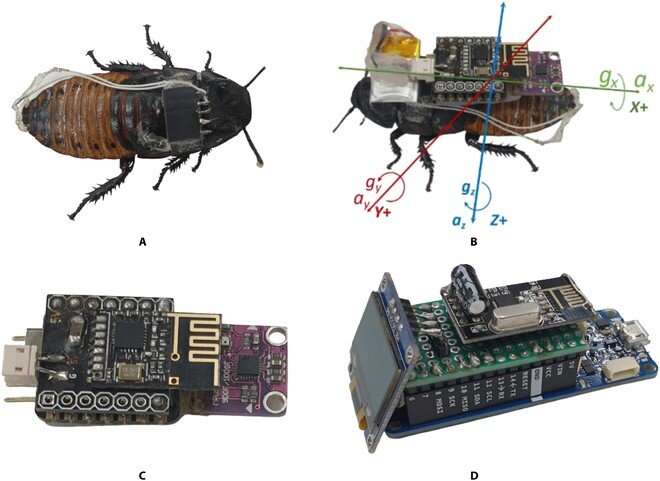This article has been reviewed according to Science X's editorial process and policies. Editors have highlighted the following attributes while ensuring the content's credibility:
fact-checked
proofread
Exploring movement optimization for a cyborg cockroach with machine learning

Have you ever wondered why some insects like cockroaches prefer to stay or decrease movement in darkness? Some may tell you it's called photophobia, a habit deeply coded in their genes. A further question would be whether we can correct this habit of cockroaches, that is, moving in the darkness just as they move in bright backgrounds.
Scientists from Osaka University may have answered this question by converting a cockroach into a cyborg. They published their research in the journal Cyborg and Bionic Systems.
With millions of years of evolution, natural animals are endowed with outstanding capabilities to survive and thrive in hostile environments. In recent years, these animals have inspired roboticists to develop automatic machines to recapitulate part of these extinguished capabilities, that is, biologically inspired biomimetic robots.
An alternative to this path is to directly build controllable machines on these natural animals by implanting stimulation electrodes into their brains or peripheral nervous system to control their movement and even see what they see, so-called cyborgs. Among these studies, cyborg insects are attracting ever-increasing attention for their availability, simpler neuro-muscular pathways, and easier operation to intrusively stimulate their peripheral nervous system or muscles.
Cockroaches have marvelous locomotion ability, which significantly outperforms any biomimetic robots of similar size. Therefore, cyborg cockroaches equipped with such agile locomotion are suitable for search and rescue missions in unknown and unstructured environments that traditional robots can hardly access.
"Cockroaches prefer to stay in the darkened, narrow areas over the bright, spacious areas. Moreover, they tend to be active in the hotter environment," explained study author Keisuke Morishima, a roboticist from Department of Mechanical Engineering, Osaka University, "These natural behaviors will hinder the cockroaches to be utilized in unknown and under-rubble environments for search and rescue applications. It will be difficult to apply a mini live stream camera attached to them in a dark or without light areas for real-time monitoring purposes."
"This study aims to optimize cyborg cockroach movement performance," said Morishima. To this end, they proposed a machine learning-based approach that automatically detects the motion state of this cyborg cockroach via IMU measurements. If the cockroach stops or freezes in darkness or cooler environment, electrical stimulation would be applied to their brain to make it move.
"With this online detector, the stimulation is minimized to prevent the cockroaches from fatigue due to too many stimulations," said Mochammad Ariyanto, Morishima's colleague from Department of Mechanical Engineering, Osaka University.
This idea of restraining electrical stimulation to necessary circumstances, which is determined by AI algorithms via onboard measurements, is intuitively promising. "We don't have to control the cyborg like controlling a robot. They can have some extent of autonomy, which is the basis of their agile locomotion. For example, in a rescue scenario, we only need to stimulate the cockroach to turn its direction when it's walking the wrong way or move when it stops unexpectedly," said Morishima.
"Equipped with such a system, the cyborg successfully increased its average search rate and traveled distance up to 68% and 70%, respectively, while the stop time was reduced by 78%," said the study authors. "We have proven that it's feasible to apply electrical stimulation on the cockroach's cerci; it can overcome its innate habit, for example, increase movement in dark and cold environments where it normally decreases its locomotion."
"In this study, cerci were stimulated to trigger the free-walking motion of the Madagascar hissing cockroach (MHC)."
More information: Mochammad Ariyanto et al, Movement Optimization for a Cyborg Cockroach in a Bounded Space Incorporating Machine Learning, Cyborg and Bionic Systems (2023). DOI: 10.34133/cbsystems.0012


















